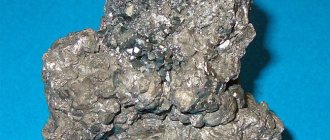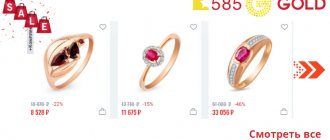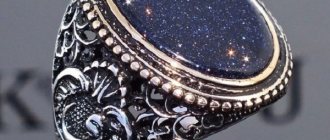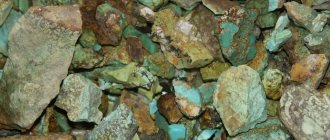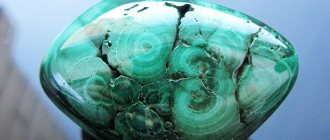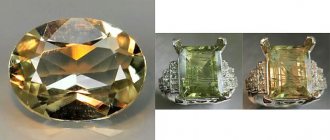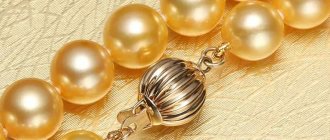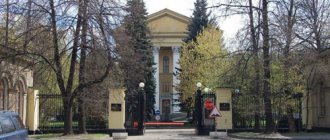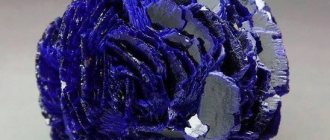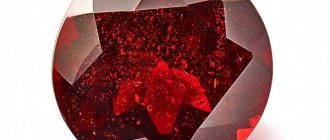There are several ways to distinguish natural turquoise from a fake. But first we need to understand why they appear on the jewelry market and how they are made. Indeed, among the imitations there are very high-quality specimens, sometimes not inferior in beauty to natural stones. We suggest studying the properties of the mineral, the types of possible fakes, and also using our tips for checking jewelry for originality.
Characteristics of natural stones of the turquoise market
According to official data, turquoise production in the world is declining, many mines are depleted. However, there is no shortage of jewelry with this stone on the jewelry market. In addition, increasingly larger inserts are appearing in rings and earrings. The conclusion is clear - the modern world is flooded with imitations.
The name reflects one of the possible colors of the mineral. But in nature there are white and blue, yellow and light green, brown and green specimens. The color types of turquoise are characterized by various intermediate tones. Moreover, a variety of shades is sometimes present even in a single nugget.
The color is not always distributed evenly. Various inclusions and grids, which are called the turquoise matrix, create transitions from one range to another. Such stones are prized by collectors due to their rarity.
But the ideal mineral is a rich turquoise color, which is called royal blue. In second place in the evaluation are density and hardness. The higher the indicators, the more expensive.
Characteristics of a real gem
Natural turquoise is a semi-precious stone with a varied color palette. The tones of the mineral range from soft blue to bright blue; some specimens can be white or green. The natural sea green color is considered the most exquisite, but many people prefer the sky blue color.
Such a variety of gem tones is an advantage for creators of imitations. Unscrupulous jewelers often pass off colored glass or cheap rocks as real stones, which are difficult for the average person to distinguish from a natural gem.
Deposits of natural turquoise do not last forever, and large minerals are almost never found in the deposits.
Therefore, if the price of a piece of jewelry is suspiciously low, we can say with confidence that it is a fake and not a semi-precious natural stone.
Characteristics of real turquoise:
- price - from 5 dollars per carat;
- wide range of shades;
- hardness - 6 units. according to the Mohs scale;
- there is no transparency;
- shine - weak, waxy;
- density - 2.6-2.8;
- discolors when exposed to direct sunlight;
- fracture - conchoidal;
- syngony - triclinic;
- dispersion - absent;
- fades with prolonged contact with moisture.
Characteristics and deposits
Turquoise is characterized by porosity, which allows it to absorb fats and liquids. This directly affects the color and has even given rise to legends about the color of the stone changing when it changes hands. Such observations suggested the process of improving the quality of stones back in ancient times. Today, impregnation is done with paraffin, acrylic, resin or wax.
The name of the mineral was given by the Persians. It is similar to the Persian word “firuze”, which means “stone of happiness”. Commonly recognized colors include:
- blue;
- green;
- light blue;
- blue-green.
Even pink turquoise is very rare in nature. Possible inclusions of other minerals emphasize the authenticity of the gem. Strong shine does not appear even after sanding; it remains matte against a background of zero transparency. Hardness does not exceed 6 units, and density stops at 2.8. Find out more in the article “Turquoise stone: properties and who it suits according to zodiac sign”
The leader in turquoise production is the USA (Arizona, Colorado, California). Also mined in Egypt, Argentina, Iran.
The magical properties of turquoise stone
A talisman with turquoise is suitable for those who like to travel.
It will add energy and protect you on the road. In ancient times, the magical properties of the mineral were valued no less than their medicinal properties. Many peoples used this magic stone to attract good luck into their lives and protect themselves from the evil eye.
How else can you use the mineral:
- To reconcile with enemies, give your ill-wisher a blue talisman and you will soon get along.
- For healing the soul during unrequited love or after a breakup with a loved one. Turquoise for men can become an effective talisman against betrayal. It is known that in the Middle Ages, women secretly sewed small stones into the clothes of their chosen ones in order to forever tie them to themselves.
- For protection on the road. They took the mineral with them on trips so that it would protect them from troubles.
- For energy replenishment. The stone cleanses the owner’s biofield and replenishes its supply of vital energy.
- For guard. Talismans were given to children, relatives, friends, or bought for themselves. According to legends, they protected envious people from negative influences and warded off evil spirits.
When choosing a magical talisman for yourself, pay attention to its color. White turquoise is a young mineral; it has not yet gained strength from nature, and therefore it will be of little use in esoteric terms. The magical properties of green turquoise also leave much to be desired.
Like green-blue or gray, it has practically lost its witchcraft value. Therefore, it is better to avoid dark turquoise. Look for talismans in blue shades - they will become the best companions!
Variations of natural turquoise
Jewelry turquoise stones come in different qualities. The first, so-called natural group includes expensive and rare gems that do not require artificial improvement. Mechanical cutting and grinding is enough for them.
Fortified turquoise is one that has been treated with cement (natural or artificial). Such minerals are also called stabilized or cemented. Usually wax, evaporated quartz or polystyrene are used for this. This improvement method is aimed at further strengthening and preserving the durability of gems that initially do not have the required hardness. The quality of the resulting stone is close to natural.
The third group is refined turquoise. This involves not only strengthening, but also touch-up. The cost of such stones is significantly lower than the first two, because this improves fragile minerals, pale in color and with a poor-quality structure.
The low grade of turquoise, respectively the cheapest, is made from the powder left over from high-quality minerals after processing. The pressing method is used. Despite the fact that pressed turquoise is created from pieces, it is considered real, like all of the above types, which contain natural gems.
Imitation turquoise
5) IMITATION TURQUOISE (Imitation turquoise) is not turquoise at all, but either
a) natural minerals colored in the mass, or
b) artificial materials that imitate the color of natural turquoise.
Turquoise has always encouraged stone cutters to look for similar minerals that, in their natural form or after artificial coloring, could be used in jewelry instead of turquoise. Back in 1546, Agricola wrote: “No other precious stone can be so indistinguishably imitated as turquoise...”. Now there are about twenty such minerals. Minerals such as howlite, magnesite, cachalong, chrysocolla, low-grade lapis lazuli, chalcedony, and jasper are often used as natural imitations of turquoise. There are imitations made of fired plaster and alabaster. Also, turquoise is very often counterfeited with plastic (it melts and stinks when heated, it is not porous), surface staining with copper of bone and similar materials (white inside, the method of separation is the ability of organic matter to burn), glass and porcelain, etc.
Ancient methods of making fakes
Above we explained what pressed turquoise is and why it is considered natural. Now let's talk about fakes. There is an abundance of this goodness on the market, despite the variety of varieties of turquoise and different prices depending on the variety.
Even the ancient Egyptians learned to paint ordinary glass and pass it off as turquoise. This was the 5th century BC. And almost at the same time, imitations began to be made by sintering silica, soda, calcium carbonate and copper components.
Later, porcelain and plastics, animal bones and teeth were used. The powdered components were dyed and pressed using a method similar to the method used to obtain pressed natural turquoise. Such fakes looked very believable, had a non-uniform surface and beautiful shades.
Properties
Inconspicuous at first glance, howlite has a number of properties. This allows it to be used in lithotherapy and magic.
Magical
It is believed that the mineral helps the owner's soul to travel beyond the body and visit the places it wishes. This property is especially valued during meditation, when you need to concentrate, free yourself from thoughts and clear your mind.
The magical properties of the gem also include:
- helps to calm down and find inner harmony;
- reveals talents, inspires;
- enhances intuition and insight;
- helps to better assimilate new information;
- fills a person with a good mood, love of life, optimism, faith in the future;
- fights blues, sadness, despondency.
Medicinal
The stone is also widely used in lithotherapy. Its main manifestations in this area include:
- has a positive effect on the condition of teeth and bones;
- promotes rapid recovery after fractures and bruises;
- treats diseases of the cardiovascular system;
- calms, eliminates insomnia, disturbing dreams;
- cleanses the blood of toxins;
- strengthens the immune system, protects against infections and bacteria.
Do not forget that lithotherapy is an alternative medicine. Therefore, in case of any ailment, you should first contact a qualified doctor, who will refer you for examination, make a diagnosis and prescribe medication. Healing with howlite can only be used as an auxiliary tool, but not the main one!
Types of modern fakes
Nowadays, the technologies of the ancients are not forgotten, but are used taking into account modern realities. Glass, plastic, porcelain and enamel are all also painted by skilled swindlers. But professionals have appeared who can make turquoise from other natural stones. Typically used:
- chalcedony;
- howlite;
- quartz;
- lazulite;
- variscite.
The dyeing method is also used here. Howlite, which is characterized by white color and dark veins, is considered the best imitation material. It is similar in quality to turquoise, but surpasses it in durability. The stone has a characteristic porcelain shine.
There is an imitation called “African turquoise”, which is actually dyed jasper. In Africa, turquoise is found only in Tanzania.
Also, with the help of modern technologies, synthetic turquoise and the so-called Viennese turquoise are grown in the laboratory. We'll tell you more about it below. If you are interested in the topic of fakes, then read the article “Difference between synthetic artificial sapphires and natural ones.”
5.1) NATURAL IMITATIONS OF TURQUOISE
5.1.1) HOULITE (synonyms: howlite, kaulite, silicoborocalcite; turquenite
a) a type of howlite or
b) turquoise-colored howlite) is a cheap natural mineral that imitates both natural and synthetic turquoise, lapis lazuli, pink and red corals. The color of natural howlite is usually white or gray, and minerals with brown and black veins are often found (these veins resemble the veins of turquoise). Howlite is two units softer than turquoise. Howlite is easily dyed in blue, turquoise, green and any other tones and therefore very often acts as a substitute for turquoise (as well as red or pink corals). The imitation is so accurate that some sellers, knowingly or unknowingly, pass off colored howlite as real high-grade turquoise. Howlite is cut into beads, cabochons and even small figures, while turquoise is not found in large and large pieces (unlike Howlite). The polished surface of howlite shines like porcelain (another difference from turquoise). The main deposits are located in Nova Scotia (Canada). Howlite is also found in California (USA). If you have inexpensively purchased howlite, dyed or natural color, this is a good purchase. But if you were sold howlite under the guise of another expensive and valuable mineral (for example, turquoise, coral), then this is a substitution and pure fraud.
5.1.1) ODONTOLITIS
In the form of turquoise counterfeits, odontolite and processed bone, colored accordingly, are used. Ondolite is very similar in appearance to turquoise, it is often called “bone turquoise”, “turquoise tooth”, “Western turquoise”. Substantiating the hypergene genesis of turquoise, some authors [Da na E. S., 1937] believe that odontolite is the bones and teeth of animals impregnated with turquoise. Indeed, odontolite is not a mineral and represents the bones of extinct animals, but impregnated not with turquoise, but with aqueous iron phosphate vivianite Fe3 (P04)2-8H20, sometimes called “blue iron earth”. Some odontolites are impregnated with copper minerals, then their color is green. Moderate heating of a gray-blue odontolite gives it a sky blue (turquoise) color. If the bones are saturated with copper salts, the odontolite turns green when heated. The refractive index of the odontolite is 1.57–1.63. Hardness 5. Density above 3 g/cm3. Boils from hydrochloric acid. The primary organic structure of the mineral is visible in thin sections. Odontolite is easily recognized when examined under a magnifying glass by its characteristic cellular structure of bone. A drop of hydrochloric acid leaves numerous bubbles on its surface - evidence of a reaction with calcium carbonate present in the bone.
5.1.2) VARISCITE - hydrous aluminum phosphate - Al(P04)-2H20
Usually contains some amount of iron, physical properties are close to turquoise. Copper is not part of the mineral. The color is green, dark green, blue and yellow. Glass shine. Forms crusts, nodules, and rarely octahedral crystals. Hardness 4-5. Density 2.4-2.5 g/cm3. There is no cleavage. Refractive index up to 1.57. Variscite was found in Saxony, in an area previously called Variscia, which gave the name to the mineral. A mineral found in Australia with the properties of variscite is called “Australian turquoise” or “Australian jade”. The most common varieties of variscite develop in the form of eyes, which is not typical for turquoise. Variscite is an American gemstone and is highly prized. High quality variscite is as rare as good turquoise, if not rarer.
5.1.3) CHRYSACOLLA
A mineral that is often mistaken for turquoise. It is a hydrous copper silicate with highly variable composition and variable constants. The color is blue, cyan and bluish-green. Hardness 2-4. Density 2-2.4 g/cm3. Refractive index 1.50. Widely developed in the oxidation zone of polymetal and copper deposits, it forms crusts and thin veins; spherulites are very characteristic, often developing along turquoise.
5.1.4) FAUSTITIS
Zinc analogue of apple green turquoise is ZnAl6 (P04)4(OH)8 -5 H2 O. Composition (in%): CuO 1.61, ZnO 7.74, A1203 35.31, Fe203 1.73, P205 34.83, H20 18.78. Faustite forms veins and nodules. The fracture is smooth and slightly conchoidal. Hru pok. Density 2.92 g/cm3. Hardness 5.5. The structure is micrograined, the refractive index is 1.61. The X-ray patterns of turquoise and faustite are close.
5.1.5) LASULITE
The mineral is similar in chemical composition to turquoise; it is a hydrous aluminum phosphate and contains impurities of iron and magnesium. Forms an isomorphic series from light blue lazulite - (Mg, Fe) A12 (P04)2 (0H)2 to dark scorzalite - (Fe, Mg) Ai2 (P04)2 (OH)2. Hardness 5.5. Density 3.1 g/cm3, which differs from turquoise. Refractive index 1.61-1.64. The mineral is sometimes called "bluespar". Unlike fine-crystalline turquoise, it is represented by a fine-grained aggregate. Known in Switzerland, Brazil, and the USA (New Mexico and California). There are small deposits of lazulite in Canada. In the deposits of Central Asia, bluish crusts and veins are observed, reminiscent of the described mineral.
5.1.6) COLORED QUARTZ
The material, significantly cheaper than turquoise, is offered by American gemstone suppliers.
5.1.7) STELLARITE
A unique combination of azurite, copper silicates, turquoise, malachite, chalcocite, native silver and iron sulfides. Found in the southwestern United States, it has an original color (two shades of blue on a black and silver background), is highly polished and can be used in silver and gold jewelry.
5.1.8) VARDIT
Hydrous aluminum phosphate - NaAl3 [(OH)4(P04)2 ] -2 H20 or Na4CaAl12(P04)8(OH)18 6H20. A rare mineral, somewhat similar to turquoise, occurs in the form of bluish-green nodules in the voids of variscite nodules in pcs. Utah (USA). Hardness 5. Density 2.81 g/cm3. Refractive index 1.590-1599.
5.1.9) ALUMOCHALCOSIDERITE
The mineral intermediate between chalcosiderite and turquoise is CuAl2Fe4(OH)8 (P04)4 -5 H20. The color is deep green, grassy to bluish green. The fracture is uneven to the point of becoming concholic. Hardness 4.5. Density 3 g/cm3. Forms small spherical aggregates and crusts.
5.1.10) RASHLEICHIT (RASHLEIT)
In composition it is also an intermediate mineral between turquoise and chalcosiderite. Rich in iron (up to 20%), the color is dominated by green tones. Macroscopically indistinguishable from green varieties of turquoise.
5.1.11) CHALCOSIDERITE
The ferrous analogue of turquoise is CuO-3Fe203-•2P205-9H20, colored in light yellow-green tones. Triclinic syngony. Optically negative mineral. Hardness 4.5. Density 3.1 g/cm3. Forms clusters of sheaf-shaped crystals and crusts.
5.1.12) JASPER AND CHALcedony
Dyed jasper is used to imitate the so-called. called "African turquoise" with a slight greenish tint. In addition, there is an imitation of turquoise, represented by chalcedony, painted in the appropriate color. These stones are more transparent than turquoise. Their density is 2.63 g/cm3. Refractive index 1.53.
5.1.13) PROSOPITES
Thanks to the admixture of chromophores, prosopite resembles high-grade turquoise.
5.1.14) MAGNEZITE
5.1.15) CAHOLONG
The imitation is obtained by deep staining of cacholong
Determining authenticity in simple ways
Let's take a closer look at how to distinguish natural turquoise from fakes. Some experiments that can be easily carried out even at home will help us.
The authenticity of natural stone is revealed by its weight. Feel the mass of the mineral when you take it in your hand. Even without a scale, you can feel the heaviness of the gem. Materials that are made artificially are much lighter.
To check the interference of coloring substances, it is enough to wipe the test stone with an alcohol wipe. If the turquoise is natural, then there will be no trace of paint left. A poor-quality imitation will reveal itself as greenish residue on the fabric.
Pay attention to the veins. In a natural mineral, the contrast with the main color cannot be too obvious. Harmony is the main feature of naturalness.
Organic fakes
In ancient times, ondolite was often passed off as natural turquoise. These are fossils (ivory, teeth of ancient animals, etc.) that were colored blue or greenish due to the high copper content in the accompanying rock. Outwardly, ondolite really resembles turquoise, but it dissolves in hydrochloric acid and, upon closer examination, reveals its organic structure.
So, even if you carefully examined the stone before purchasing, it would not be a bad idea to ask the seller for a certificate for the product, and also to clarify the place of origin of the gem. This simple measure, together with care when purchasing, will protect you from accidentally purchasing a fake.
Tests by fire and needle
If you take real turquoise in your hand, the stone will seem cold. However, the mineral will gradually heat up. Synthetic samples lack this ability. It is easy to spot a fake by fire testing. When heated in the flame of a match or candle, it emits a melting smell.
To avoid accidentally damaging the decoration, conduct the experiment on the side hidden from view. It is acceptable if natural turquoise shows cracks in the direction of the veins. When a more durable howlite is used in the simulation, its appearance will not change.
A similar test method is to pierce the sample with a hot needle. The plastic will melt, and the turquoise-colored stone at the puncture site will become lighter. If you see a stabilized type of mineral, then it is quite possible that the impregnation used will appear.
Scratching with a needle will also help identify a fake. But such manipulations need to be done only on the back side of the stone. The plastic will begin to crumble, the howlite will pass the test, and the remaining scratch will confirm that it is real turquoise.
Origin of the mineral
Howlite is a stone that is named after its discoverer, Henry Howe.
Henry Howe was a geologist and specialist in rare rocks. In 1868, he discovered an interesting gem in Canada on the Nova Scotia Peninsula.
There is another transcription option - howlite.
Howlite is also called turquenite. Being discovered in the era of rationalism, the stone does not appear in the myths and legends of European peoples. It was studied only by the scientific method.
Howlite was first discovered in Canada.
But the Indians, the indigenous inhabitants of North America, knew about howlite for a long time. They called it "white bison" or "sacred bison." Archaeologists find pendants, amulets, and magical objects made of howlite at excavations of settlements and sites of ancient tribes.
With the help of the gem, the Indians performed rituals to protect against evil spirits, as well as rituals that were supposed to bring good luck. Europeans, when they began to use jewelry with a Canadian wonder, also learned about the magical properties of the stone.
However, Indian shamans warned: the “white bison” does not like it when he is not accepted for who he is. It was strictly forbidden to paint or draw anything on the mineral.
We look inside and put pressure on the psyche
Now we’ll tell you how to distinguish natural turquoise in beads. A visual inspection of the internal hole is sufficient here. If it retains the basic color, then the stone is genuine.
Also remember that natural turquoise does not come in large sizes. Usually the gem does not exceed 1 cubic meter. cm in volume. However, if you press small particles, you get large stones. The cost of the product also makes it possible to recognize its naturalness. The price of the original is 10-15 thousand rubles. Smaller amounts make you think - it is quite possible that this is artificial turquoise.
If the purchase is made in a specialized store, then it is possible to see the certificate. Forgery of a document is possible, but asking to show it has a magical effect. Fraudsters appear confused.
The certificate of conformity indicates the variety offered for sale. Then it’s easy to find out what exactly is in front of you. But it is best to seek advice from a professional who understands turquoise and knows for sure how to distinguish a fake. Therefore, we advise you to look for proven gemologists who constantly work with the rock and jewelry.
How to distinguish natural turquoise from its imitations?
The question of how to distinguish natural turquoise from its imitation is usually more difficult to answer than in the case of malachite . This complexity stems from the fact that we see many imitations of turquoise on the shelves, and they are different. In a rare jewelry store you won’t see bracelets, beads, pendants, rings and earrings with this stone, but handicraft materials stores are completely littered with a variety of beads, “nuggets”, crumbs, and cabochons made from it. Even at a quick glance you can see the differences: these samples are bright blue with a glossy sheen and black veins, some have solid brownish-brown veins, others have a matte surface with slight abrasions and a greenish color... These are more expensive, those are cheaper... It makes sense Question: which of them are natural turquoise? The answer is simple: none.
Yes Yes. There is not a single piece of natural turquoise in this photo!
I foresee the reader's surprise at this. Let's clear things up. Any beautiful stone inserted into a brooch, pendant or ring was once mined somewhere. And its value, along with its decorative properties, is necessarily based on how rare it is in the bowels of the earth, whether it is easy to extract, bring, and process it to a state suitable for jewelry use.
Since ancient times, turquoise has been highly valued and inserted into various jewelry, believing in its magical power to store and increase the wealth of its owner, to give him eternal love and happiness in marriage. Needless to say, its extraction sites have been developed for many millennia, and since they are usually not too large, they are exhausted quite quickly, and the extraction itself is expensive. At the moment, turquoise all over the world is only growing in price, and it is no longer available. Where does such an abundance of the “stone of happiness and love” come from on store shelves, and at a very affordable price? I think you already understood it yourself.
Ancient Egyptian jewelry with turquoise
Turquoise cannot yet be called a mineralogical rarity. But it is also not a common stone on sale and is not cheap. Once again: turquoise is expensive! Very expensive. And therefore, firstly, natural turquoise is not included in stamped Chinese jewelry for three hundred rubles per set (for this money you can buy one tiny pebble), and secondly, it is not sold very often in art supply stores. At all. Even if it's tiny. A low price is an excellent indicator of the authenticity of a stone, and this already helps a lot in identifying fakes. Although many sellers have long understood this and often ask fabulous money for fakes.
Now let’s go over the methods of processing turquoise, and also, in parallel, the methods of its imitation and “upgrade” to increase the price - fair and not so fair.
STABILIZED, PRESSED, COLORED…
Case one: you firmly decided to buy a real stone, or even several, and approached the issue with all seriousness. You are looking for a supplier (of course, this will not be the first seller of the first store you come across, no matter what he assures you of). Compare prices, consider different offers. The fact is obvious: you do not have such accurate and complete mineralogical knowledge to distinguish between varieties of turquoise by eye and determine the adequacy of prices. Otherwise, you wouldn’t be reading this article right now, right? 
Well, here it is: if we are talking about such a serious purchase and you do not want to be deceived, contact a professional consultant, and it is very desirable - one who would not be related to the supplier you have chosen, if the latter is not trusted. Of course, this will require additional payment, but in the case of such a purchase it is justified - this is the price of system knowledge, which you need to spend several years acquiring. It's not possible to have a solid idea of what you're taking in five minutes or even a week. It is better to seek help from an expert, because distinguishing between varieties of natural turquoise, including refined ones, is a delicate matter. What are these varieties?
The ideal option is a stone that was simply mined from the depths of the earth, polished and inserted into jewelry. I’ll say right away: you just won’t find one like this on sale. Even in the average jewelry store - no.
Due to the fact that in many areas of turquoise mining there is not so much turquoise left, and it is most often found in small fragments, this stone often needs to be strengthened in various ways in order for it to become suitable for jewelry. It can be porous, too soft, with cracks, and so on. Impregnation with strengthening compounds helps - such turquoise is called stabilized. It is natural in origin, and with the help of this treatment it is protected from cracking and other possible “accidents”, as well as from rapid fading of color, which is a fairly common phenomenon for this stone. Thus, this technological process is for her benefit, although its necessity suggests that the raw materials were not ideal. Stabilized turquoise is cheaper, but this price is also an order of magnitude different from the price of imitation (we will look at cases where scammers ask thousands of rubles for plastic a little later).
Another option is to press blocks from very fine crumbs mixed with various cementing polymers, and grind them into “pebbles” of the desired shape. By origin, such turquoise is, in fact, partially natural, but it looks different. Its quality is the lowest. The price, accordingly, too. Within the “line” of turquoise related to natural, an unscrupulous seller can pass off one variety after another. As has already been said, it is better to entrust the selection and rendering of a verdict on whether a stone corresponds to its name to a professional consultant.
What else is done with natural turquoise? It can be tinted (colored), thus improving it to greater contrast and brightness of color. As in the case of stabilization, these manipulations practically do not change its pattern and general appearance. The problem is that we are so accustomed to the look of artificial plastic turquoise that most people seriously believe that it is the real thing. And it is the contemplation of natural stone that leaves us perplexed: what was this that was offered to me?..
“I DON’T RECOGNIZE YOU IN MAKE-UP!”
Let's move on to the second case. The “turquoise” that they offer you does not cost astronomical money, it looks quite decent, it seems like it is really a natural stone, which is what you wanted. But is it the same one?
Imitating turquoise from other similar minerals is a difficult topic. There are already a couple of dozen of them used for this purpose, and the name of most of them is unfamiliar to the reader. I won’t go into unnecessary details, I’ll just say that other stones, tinted or not, but of natural origin, can be sold under the turquoise brand. The most common of them is howlite. This name, by the way, is being waved around by unscrupulous sellers who sell plastic “dummies” instead of stone: this, they say, is howlite. Not turquoise, of course, and yes, it is tinted, but everything is natural! Don't be fooled by this. Tinted howlite (itself is white with grayish or brownish veins) is far from the most common imitation of turquoise. And to listen to the remarks from behind the counters, it will seem that everything around is simply littered with them...
Howlite is a natural shade. By painting it blue, you can get stones that look like turquoise
To reduce such misunderstandings, take a look at the photographs of natural howlite. It has a fairly pleasant pattern, the shine when polished well is brighter, glossier than that of natural turquoise with its waxy texture. In terms of its decorative qualities, it is quite good! It’s just that it’s much cheaper than turquoise. It is therefore useful to know what it looks like, especially if they want to sell you on it at a high price.
Other “candidates” for imitation turquoise, from left to right: magnesite, chrysocolla, artificially colored chalcedony
...We have not yet touched on other stones that are passed off as turquoise - chrysocolla, painted chalcedony and others. We won’t go here: these cases are definitely rare, and the most useful thing, if you are planning to buy yourself a thing with turquoise, is to “train” your eye on it, the real thing, at least with the help of photo selections.
This collage features natural turquoise stones. It is unusual for our eyes...
TURQUOISE WITHOUT TURQUOISE
Finally, case three. You are not at all happy to pay thousands of rubles for one beautiful stone - you just want something “turquoise” to go with your favorite scarf or dress. In this case, feel free to buy polymer or ceramic imitation - they can be really beautiful. But don’t buy into the seller’s attempts to give you a string of beads for several thousand. This is the most common deception, and here you need to be on your guard.
I would like to set the main goal of designating precisely these absolutely artificial types of “turquoise” with which all stores are now littered. They are recognized quite well by eye, which can already be adopted. You can learn this quickly on your own; it will be useful in any case, since these are the materials you will encounter in all regular stores.
The first option is imitation made of ceramics, alabaster, plaster and similar materials. These imitations are very widespread and it is not difficult to buy them. But getting information from the seller that the stone is artificial is usually not easy. Therefore, look at the photo.
Ceramic imitation turquoise. In the left photo, the label contains the name “pressed” - this is a lie: it’s not there at all.
Ceramic “turquoise” sometimes looks quite beautiful from a purely aesthetic point of view (I love it myself), but this does not make it natural. Usually it is a little lighter than real stone, quickly warms up in the palm of your hand, and its surface is almost always matte (at least, an even waxy sheen is not inherent in this material at all). The veins on such beads, cabochons or crumbs are brown or brown in color, the thickness of these lines is the same along the entire length, and the intensity of their color also does not change. If you split such a sample, there will be an unpainted area inside with a texture characteristic of ceramics. Some of them even lose paint from the surface if you rub it with a cotton swab moistened with alcohol - here's another test for you.
And this is also sold as turquoise. At best, making excuses by saying that it is “painted.” There is paint, but no turquoise...
Another type of imitation turquoise is made of plastic. Such “pebbles” are often bright blue in color, without a greenish tint, with black veins, the pattern seems to be a little blurred, unevenly outlined. There are also no color transitions in the veins. This type of synthetic "turquoise" is dyed throughout its entire thickness, and heat exposure is a sure indicator of a fake. If it is possible to apply a hot needle to the sample somewhere in an inconspicuous place, at the end, then you will see smoke. There will be an unpleasant smell, and a burn mark will remain. Needless to say, nothing like this can happen with natural stone.
Plastic “turquoise” looks like this. It is this material that usually melts and smokes when heated.
Let us separately mention the “nugget” beads. They are also completely artificial. Turquoise beads are a separate topic. I once read a sensible idea that it is practically impractical to do them, and this seems to be an important point. Imagine: such an amount of valuable raw materials (not every piece of turquoise mined will produce a high-quality, large enough bead!) to spend on just one piece of jewelry. Firstly, it will be very expensive. Ten thousand is a completely normal price for a short thread, and even then it’s far from the best grade. The same stones can be used for piece jewelry, which will cost much more. And beads - they are beads, their decorative value, at the most general level, is limited, and such an item will not be looking for a buyer for a day or two. Of course, they are made, but in the quantities in which we see all the time? Of course not.
Now remember once again the piles of “turquoise” beads in the photo on the Internet, your hands weighed down with a dozen or two threads of large stones. Polished beads for every taste - beads with a diameter of 8, 10, 12 millimeters, blue, greenish, with a black pattern, with a light one... The usual “landscape” of a craft materials store. Do you get it? The fact that there is a bead or beads in front of you is already a reason to actively take a closer look at what is being offered to you.
Not everything that is turquoise is made of turquoise...
In general, turquoise beads still exist. Once over the last couple of years I saw them in a specialty store, another time on the Internet. Such stones cannot be cheap. If the price is low, then this is a fake. Not “pressing” (we already wrote about this in a previous article about malachite), but an artificial imitation that has nothing in common with natural turquoise. These beads cost pennies. Don't pay dearly for them!
They even sculpt turquoise from polymer clay. These imitations do not stand up to any criticism at all, but only the most “talented” and shameless sellers can try to pass them off as “natural”. Usually it is made for purely decorative purposes, which is fully justified - if the master is talented and experienced, the result will be a beautiful thing. Hand-sculpted “turquoise” looks something like this:
SUMMARY
Turquoise is a rare stone on sale and very expensive. It is not and cannot be, by definition, in either a handicraft shop or a cheap jewelry store. Large stones and beads are especially suspicious. Imitations made of ceramics and others like them look characteristic; when chipped, they are unpainted and white; sometimes they leave a trace of paint on a cotton swab moistened with alcohol. Polymer imitations smoke, smell like burnt plastic, darken and melt if you apply a hot needle to them somewhere on the edge. Imitations of turquoise from other natural stones are varied, but are quite rare in themselves. Turquoise has no translucent areas, its shine is waxy, the main shades can be blue, greenish, yellowish, and the spots can be black and brown. You should buy it only in a trusted place (by the way, jewelry stores are not the standard here - they also constantly see jewelry with synthetics). If you have any doubts, to be completely sure, you should consult a professional gemologist: buying a natural turquoise stone, which is very expensive, requires a serious approach and clear knowledge, which you cannot get on the Internet in one day.
The turquoise in these jewelry is natural
And here is our joint work with Anton - the talisman pendant “Keeper of the River Source” with a natural turquoise stone! 
Tasha.
Photo by Tasha and from the Internet.
Sudogda, June 25, 2021
Signs of fake stones
Radical verification methods are not always convenient or possible. But if you look at turquoise through a magnifying glass with tenfold magnification, you will notice signs of an artificial fake. Cracks, bubbles and unusual color inclusions are defects that are not typical for natural stone. Noticing the high density of the rock, the shine of glass or dark spots will immediately recognize a fake stone.
Remember that howlite is denser than turquoise. A fake chalcedony will be heavier, and quartz, although it looks similar, is too transparent. Under a magnifying glass, variscite has a thin crust and sometimes crystals that resemble growths.
After reading the article “How to distinguish a real emerald from an artificial one,” you will learn methods for testing one of the most common gemstones.
Similar stones
The most popular minerals that are often passed off as turquoise are variscite and lapis lazuli . They do not contain copper, which gives a blue and greenish tint; instead, they contain aluminum phosphates. Lazulite has a fine-grained base (while turquoise is a cryptocrystalline mineral), with a hardness of 5.5 units. Lazulite is also known by another name - blue spar.
Variscite has a relatively low hardness - from 4 to 5 units. But the range of colors of this mineral is wider than that of turquoise. Variscite occurs in nature not only in blue and green colors, but also in yellow. The shine of the stone is glossy. There are characteristic crusts on the surface and, in very rare cases, crystals. However, variscite is used extremely rarely as a fake, since high-quality stones of this type are very rare, like turquoise.
Non-original types: Viennese turquoise and Neolithic
Above we looked at a certain number of turquoise fakes. Considering that people knew the stone since ancient times, a great variety of methods have accumulated. And every year new technologies are discovered. Let's take a closer look at the method of obtaining the famous Viennese turquoise, which is mentioned above.
This type of counterfeit is made by pressing, but the finished product is not any type of turquoise. The fact is that it is not the original particles that are taken as the basis, but malachite rock. Aluminum hydroxide and phosphoric acid are added to it, after which all solid materials involved in the process are crushed. Then comes exposure to high temperatures and cooling.
The imitation of turquoise obtained in this way is very beautiful in appearance, but is inferior in hardness to natural specimens. The stone does not withstand the fire test of a match or lighter and, melting, becomes black and glass-like.
Neolithic is an imitation similar in appearance to Viennese turquoise. A distinctive feature is the composition in which copper phosphate is present. This type was invented by the Germans in 1957. The main indicator of a fake is a bright green color with yellowness, which appears when exposed to hydrochloric acid.
Types of non-original gems
Varieties of fakes have been known since antiquity. There are more and more technicians. To avoid becoming the owner of an unnatural product, you should know the types of stones.
- Viennese turquoise. The pressed composition is made of malachite rock. Additional components are phosphoric acid and aluminum hydroxide. All components go through crushing and processing at high temperatures. The hardness of the Viennese type is lower than the natural samples. When heated, such a gem melts and turns black, and the original rock cracks.
- Neolithic. Synthetic turquoise appeared among fakes in the last century. The stone is visually attractive, like a genuine one. Externally, the material is blue, with sinuous veins. The blue layer is continuous and uniform. The rock contains chemical elements: copper Cu, iron Fe, bayerite. The characteristics of the Turquoise Neolithic are identical to the Viennese type of rock.
- Artificial turquoise. The structure of the stone is fragile, the hardness reaches up to 2.5 units. For counterfeiting, they take grains of the original blue and white colors. They are mixed with alkyd resin. The technique for creating an artificial mixture was developed in the USA, but it spread throughout the world very quickly.
Synthetic turquoise is used quite often in jewelry. Some craftsmen do not hide the origin of the material, others offer jewelry, presenting it as genuine and original. It all depends on the master, his attitude to the quality of his products and his reputation.
Who is suitable according to their zodiac sign?
According to astrologers, howlite is suitable for Virgo, Taurus, Capricorn and Scorpio. The gem influences them in such a way that representatives of these zodiac signs immediately feel a surge of strength and energy. The stone attracts good luck, promotes career success, helps to make only the right decisions, enhances positive character traits and neutralizes negative ones.

